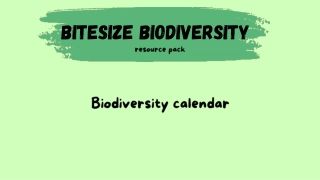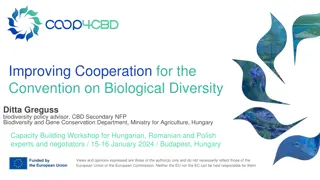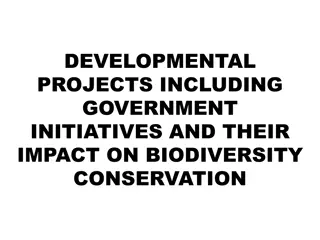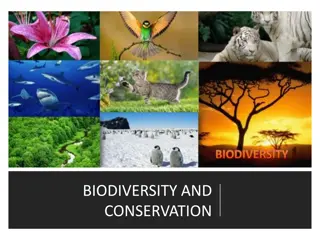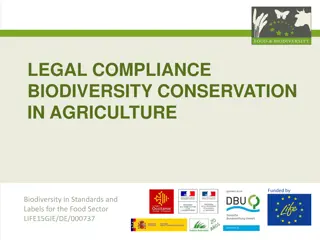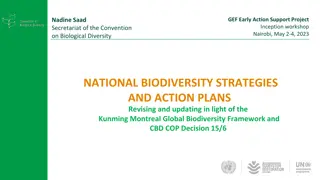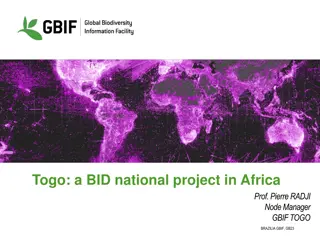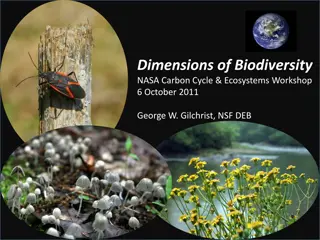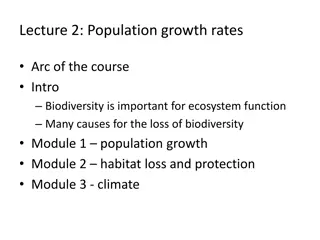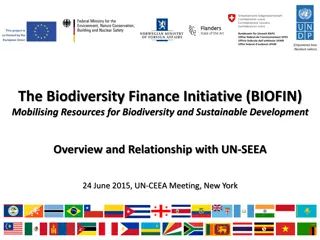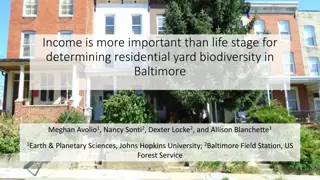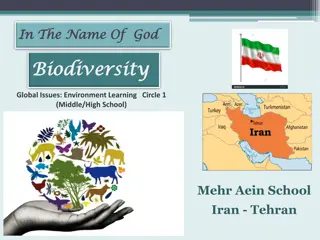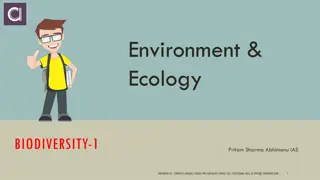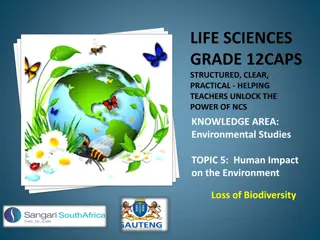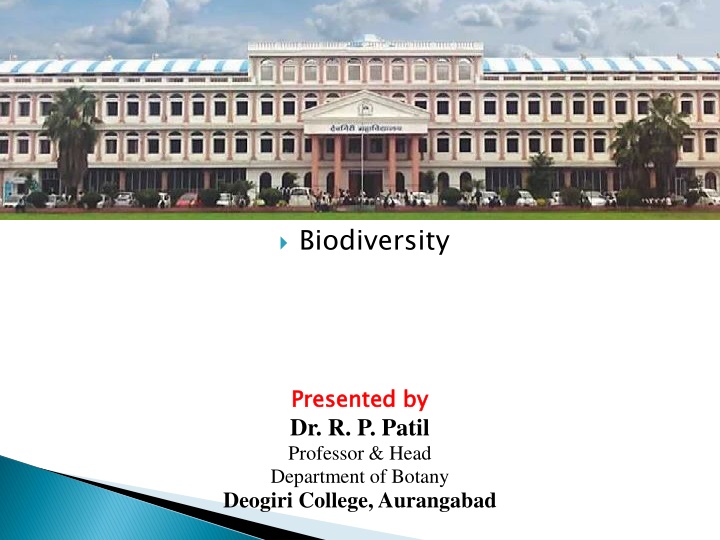
Exploring the Significance of Biodiversity in Our Ecosystem
Delve into the realm of biodiversity with Dr. R. P. Patil, as he sheds light on the definition, types, conservation, and importance of biological diversity. Uncover the wealth of life forms that support human needs and the essential role biodiversity plays in sustaining ecosystems and human development. Discover the millions of species adapting to diverse environments worldwide, emphasizing the critical value of biodiversity on Earth.
Download Presentation

Please find below an Image/Link to download the presentation.
The content on the website is provided AS IS for your information and personal use only. It may not be sold, licensed, or shared on other websites without obtaining consent from the author. If you encounter any issues during the download, it is possible that the publisher has removed the file from their server.
You are allowed to download the files provided on this website for personal or commercial use, subject to the condition that they are used lawfully. All files are the property of their respective owners.
The content on the website is provided AS IS for your information and personal use only. It may not be sold, licensed, or shared on other websites without obtaining consent from the author.
E N D
Presentation Transcript
Biodiversity Presented by Dr. R. P. Patil Professor & Head Department of Botany Deogiri College, Aurangabad Presented by
Ravi Patil Deogiri College, Aurangabad
Diversity of Angiosperms I Unit: 1 Credit 1. Biodiversity (03) Definition, concept, origin and evolution 2. Types of biodiversity: (05) Species, genetic, ecological, cropland and agricultural diversity; biodiversity in India; endemism and hot spots; threatened species, threats to biodiversity 3. Conservation of biodiversity: (07) Major causes for loss of biodiversity, listing of threatened biodiversity; threatened categories extinct, endangered, vulnerable, rare and indeterminate. Conservation measures: ex-situ, and in-situ; biodiversity conservation in India. Unit Phytotaxonomy Classification of Angiosperms with special reference to Linnaeus, A. P. de Candole, Bentham and Hooker. Study of diversity following families with reference to the system of classification of Bentham and Hooker (22) 1. Magnoliaceae 2. Nymphaeaceae 3. Papveraceae . 4. Brassicaceae 5. Capparidaceae . 6. Rutaceae 7. Rhamnaceae 8. Combretaceae 9. Lythraceae 10.Cucurbitaceae 11. Apiaceae ****** Diversity of Angiosperms I Unit: 1 Credit- -1 1 1. Biodiversity (03) 2. Types of biodiversity: (05) 3. Conservation of biodiversity: (07) Unit - -2 Credit Phytotaxonomy: (08) 2 Credit - -2 2 : (08) Study of diversity following families with reference to the system of classification of Bentham and Hooker
Biodiversity is prominent part of our daily lives and livelihood, and encompasses resources upon which families, communities, nations and future generations depend. Biological diversity is essential to the contentment of human requirements. The innumerable life forms harboured by the forests, deserts, mountains, other land, air and oceans provide food, fodder, fuel, medicine, textiles etc.
The great biological wealth of earth has provided for man s requirements over thousands of years. Biodiversity is the foundation of ecosystem services for the benefit of humanity and has been integral to the process of development through which human comfort is intimately linked. The biosphere in which all the living organisms undergoing collective metabolic activities of its innumerable plants, animals, and microbes physically and chemically unites the atmosphere, geosphere, and hydrosphere into one environmental system within which millions of species, including humans, have bloomed. .
In recent times it has been estimated that around 8.73 million species of plants, animals and micro- organisms are existing in the world. Out of these, about 1.7 million species have been identified so far. Each species is adapted to live in specific environment, from mountain peaks to the depth of seas, from polar ice caps to tropical rain forests and deserts. Biodiversity is essentially everywhere, ubiquitous on Earth s surface and in every drop of its bodies of water, in the case of microbes, they are invisible to naked human eye. All this diversity of life is confined to only about one kilometer thick layer of lithosphere hydrosphere and atmosphere which form biosphere
Biological diversity term was used first by wildlife scientist and conservationist Raymond F. Dasmann in the 1968 lay book A Different Kind of Country advocating conservation. Thomas Lovejoy, in the foreword to the book Conservation Biology, introduced the term to the scientific community.
Robert E. Jenkins, Lovejoy and other leading conservation scientists at the time in America advocated the use of the term "biological diversity". The term's contracted form Biodiversity may have been coined by Walter. G. Rosen in 1986 while planning the 1986 National Forum on Biological Diversity organized by the National Research Council (NRC).
Bruce A. Wilcox in a paper commissioned to (IUCN), in the World National Parks Conference,1982. defined as "Biological diversity is the variety of life forms...at all levels of biological systems (i.e., molecular, organismic, population, species and ecosystem)". The 1992 United Nations Earth Summit defined "biological diversity" as "the variability among living organisms from all sources, including, 'inter alia', terrestrial, marine, and other aquatic ecosystems, and the ecological complexes of which they are part: this includes diversity within species, between species and of ecosystems". This definition is used in the United Nations Convention on Biological Diversity.
Biodiversity is that part of nature which includes the differences in genes among the individuals of a species, the variety and richness of all the plant, animal species and micro-organisms at different scales in the biosphere, locally, in a region, in the country and the world, in various types of ecosystems within a defined area. Biodiversity deals with the degree of nature s variety in the biosphere this can be experiential at three levels; the genetic unevenness within a species, the variety of species within a community, and the organization of species in an area into distinctive plant, animal communities and Micro-organisms constitutes ecosystem diversity.
Biodiversity is defined as the variety and variability among the living organisms and the ecological complexes in which they occur. It refers to the variability s among species of plants, animals and microorganisms in an ecosystem; ecosystem including terrestrial, aerial, marine and other aquatic system and ecological complexes. In simpler terms, biodiversity is the assemblage of different life forms. This includes diversity species and of ecosystems. Thus, biodiversity is sum of all the genes, varieties, species, populations in different ecosystems and their relative abundance. his includes diversity within species and of ecosystems. within species, between species, between
Goddess of the Flower Flora is a collective term for a group of plant life found in a particular region. The whole plant kingdom is represented by this name. Flora is classified and differentiated based on many factors viz., desert regions or in water, some are found in hilly. Plant Kingdom includes following types which are grouped under different divisions. Algae(Almost aquatic primitive form of plants) Fungi(Non chlorophylous may be parasites pathogenic or non pathogenic or decomposers) Bryophytes(Amphibians of plants, growing in marshy areas) Pteridophytes(Plants with conducting tissues, tending towards land, roots and leaves formed ) Gymnosperms (Ovules without ovary wall advance than pteridophytes, links with angiosperms ) Angiosperms(Most advance and recent grouop of plants dominating the biosphere, ovules covered)
Fauna Goddess of fertility represents the animal life indigenous to a region. Birds are categorized in the name Avifauna while Fishes under Pisci Fauna. Invertebrates and vertebrates Microorganisms including bacteria and virus are generally considered under animal kingdom, they are known as Microfauna. All unknown and undiscovered animals are named as cryptofauna.
Earth has originated around 4600 million years ago and the origin of life on earth initiated some three and a half billion years ago are obscure, however some evidence suggests that life may already have been well-established only a few hundred million years after the formation of the Earth. Approximately 600 million years ago, all life consisted of archaea, bacteria, protozoans and similar single- celled organisms established. The history of biodiversity during the Phanerozoic (the last 540 million years), starts with rapid growth during the Cambrian explosion; every phylum of multicellular organisms first appeared. In next 400 million years invertebrate diversity formed followed by vertebrate diversity showed an overall exponential trend.
The worst was the Permo-Triassic extinction, 251 million years ago. Vertebrates took 30 million years to recover from this event. The fossil record preservation of recent geologic sections shows major diversity formation and the fossil record reasonably reflective of the diversification of life whereas others believe that modern biodiversity similar to biodiversity 300 million years ago.
ERA PERIOD MYA* LIFE AT THE TIME Many mammals vanish during a vast ice age. wide. Species of plants and animals are similar to what we see today. Modern humans emerge and spread world Cenozoic EraAgeThe Age Mammals Mesozoic Era Age Medieval Life (Time of the Ruling Reptiles) Quaterna ry 0.01 - 5 of The continents have moved to positions near where they are today.Flowering plants thrive and diversify. Vast forests exist in the tropical & temperate environments. Mammals spread and diversify. North and South America begin to split apart.India is a separate continent,In the north are Euramerica and Asiamerica, with differing plant and animal species.Dinosaurs diversify and rule until the end of the Cretaceous period when they die out in a mass extinction along with many other marine and terrestrial species. Flowering plants appear, and insects begin to pollinate. The supercontinent, Pangea, splits and the Atlantic Ocean appears separating Asia from the Americas and Africa.The age of the Ruling Reptiles is in full swing. Dinosaurs rule the earth and pterosaurs rule the skies. Dinosaurs are much larger and include giant herbivores. The first birds appear. The first dinosaurs and mammals appear; they tend to be small and quick predators who run on their back legs. Cycads abound, seed ferns go extinct. Ammonites are common. Dinosaurs, crocodiles and pterosaurs emerge and diversify. All land is in one giant continent, Pangea. Ferns, seed ferns and conifers abound. Insects diversify and spread. Many marine animals, including the trilobites, go extinct. All land is in two great continents, in the north is Euramerica and Gondwanaland is in the south. The first reptiles appear on land, as do the first conifers and cycads. Giant ferns, horsetails, and club mosses are common. Trilobites become less common, graptolites go extinct. Amphibians and insects begin to invade the land. appear. Fish abound. The first life emerges on land, as plants and invertebrates. Fish develop and split into the bony fishes (teleosts) and the cartilaginous fishes (sharks and rays). Marine invertebrates continue to thrive. Corals, bryozoa and graptolites thrive along with the marine life of the Cambrian. The first true vertebrate fish discovered. Tertiary 5 - 145 Cretaceo us 145 - 200 of Jurassic 200- 250 Triassic 250 - 295 Paleozoic Era Age Ancient Life Permian 295 - 362 Carbonife rous 362 - 418 of The earliest ferns and plants with seeds Devonian 418 - 439 Silurian 439 - 490 Ordovici an 490 - 543 Marine life abounds, including red and green algae, brachiopods, gastropods, trilobites, sponges. The earliest fishes appear. Cambrian 543 - 2500 Time from the birth of the planet approximately 4.6 bya, until the first simple lifeform appeared about 3.6 bya, including early bacteria & blue-green algae. The first multicellular animals, such as worms and jellyfish, appeared near the end of this era. Precambria nEra (Time before Life) 2500 4600
There are three interrelated hierarchical levels of biodiversity namely, Genetic diversity, Species diversity and Ecosystem diversity or Community diversity. Beside these three one of the most important type has pulled attention recently is agricultural and cropland diversity due to loss of wild varieties in the biotechnological era or green revolution. Biodiversity encompasses the variety of life on earth and includes variation at all levels of biological organization from genes to species to ecosystems. Genetic, organism and ecological diversity are all elements of biodiversity with each including a number of components. It refers to the variety within and among living organisms, biotic communities, and biotic processes, whether naturally occurring or modified by humans.
Genetic diversity is the total number of genetic characteristics in the genetic makeup of a species. It describes the variation in the number and types of genes as well as chromosomes present in different species. The magnitude of variation in genes of a species increases with increase in size and environmental parameters of the habitat. Genetic diversity is reliant on the heritable variation within and between populations of organisms.
Genetic diversity pertains to the range of diversity in the genetic resources of the organisms . Every individual member of a plant or animal species differs from other individuals in its genetic constitution. Each individual has specific characters, which is due to the genetic makeup or code. The genes present in the organisms can form infinite number of combinations that causes genetic variability. This genetic variability is essential for a healthy breeding population of a species. If the number of breeding individuals is reduced, the dissimilarity of genetic makeup is reduced and in-breeding occurs.
Eventually this can lead to the extinction of the species. The diversity in wild species forms the gene pool which our crops and domestic animals have been developed over thousands of years. This forms the basis of adaptation among the living organisms. India has high genetic diversity and is regarded as a Vavilov s centre of high crop genetic diversity so named after the Russian agro-botanist N I Vavilov, who identified eight such centres of origin of cultivated plants around the world in the 1950s. Specialty of Genetic diversity: (i) It helps in speciation or evolution of new species; (ii) Genetic diversity allows species to adapt to changing environments species survive drastic changes desirable genes (iii) It is important for agricultural productivity and development. gene pool from Specialty of Genetic diversity: adapt to changing environments. This diversity aims to ensure that some survive drastic changes and thus carry on desirable genes. carry on
According to Biological Species Concepts (BSC), species is a basic unit of classification and is defined as a group of similar organisms that mate with one another and produce offspring s and share a common lineage. Species diversity refers to the variety of species within a geographical area. Species that differ from one another in their genetic makeup do not interbreed in nature. Species diversity refers to biodiversity at the most basic level and is the variety and abundance of different types of individuals of a species in a given area. It includes all the species on Earth, ranging from all microbes, plants such as fungi, algae, bryophytes, pteridophytes, gymnosperms, angiosperms and all the species of animals including unicellular protozoans to mammals.
At present conservation scientists have been able to identify and categorize about 1.7 million species on earth and many more are yet to be discovered. It has been currently estimated that the total number of species may vary from 5 - 50 millions. Worldwide 36 such Hotspots are notified with 17 Mega Diverse regions this date. India is a country of vast diversity and is among the world s 17 nations that are exceptionally rich in species diversity along with two hot spots as Eastern Himalayas and Western Ghats. Specialty of Species diversity: Species richness: in a defined area. (b) Species abundance: among species. For example, the number of species of plants, animals and microorganisms may be more in an area than that recorded in another area. (c) Taxonomic or genetic relationships between different groups of species. Specialty of Species diversity: Species richness: Refers to the number of various species Species abundance: Refers to the relative numbers Taxonomic or phylogenetic phylogenetic diversity: diversity: Refers to the
It is referred as Land escape diversity because it includes placement and size of various ecosystems. The earth has a number of ecosystems like grasslands, forests, semi arid deserts, marine, freshwater, wetland, mountains swamp, marshlands etc. Likewise, every ecosystem or habitat is having its distinct floral, faunal and microbial assemblages, so such variations at ecosystem level are termed as ecosystem diversity.It describes the assemblage and Interaction of species living together and the physical environment a given area. It also includes variability within the same species and variability among the different species of plants, animals and microorganisms of an ecosystem. It pertains to the richness of flora, fauna and microorganisms with in an ecosystem or biotic community. The richness of the biosphere in terms of varied life forms is due to the variations in the ecosystems.
For instance, the tropical south India with rich species diversity will have altogether different structure compared to the desert ecosystem which has far less number of plant and animal species. It may be more variable to the Alpine ecosystem. Ecosystem diversity can be described for a specific geographical region, or a political entity such as a country, a state or a region, or a district. Distinctive ecosystems include landscapes such as forests, grasslands, deserts, mountains, etc., as well as aquatic ecosystems such as rivers, lakes, and the sea.
Alpha diversity ( It is related with the species diversity in a given community. It is the biodiversity within a particular area, community or ecosystem. It is usually expressed by the number of species in that ecosystem or in one type of habitat. This can be measured by counting the number of taxa within the ecosystem (e.g. Families, genera and species). This depends on the interaction between the biotic and abiotic factors and also takes into account immigration from other locations. Alpha diversity ( - -diversity) diversity) Beta diversity ( Beta diversity is a measure of biodiversity which works by comparing the species diversity between ecosystems or along environmental gradients, usually measured as the change in the amount of species between the ecosystems. It is a comparison of diversity between ecosystems it describes a range of communities due to replacement of species which arises due to the presence of different microhabitats, niches and environmental conditions. It gives a quantitative measure of diversity of communities that experience changing environments. This is the change in the composition of the species with reference to the changes in the environment. Such type of diversity is transect or intersect of more than two ecosystem in reference with total amount of species. Beta diversity ( - -Diversity) Diversity) Gamma diversity ( It refers to the overall diversity or species richness in a large area with different types of ecosystems. It describes diversity of habitat over a total landscape or geographical area. It is a measure of the complete diversity for the different ecosystems within a region. This refers to the overall diversity and is applied to larger areas in which both alpha diversity of component ecosystems and the beta diversity between component ecosystems. Gamma diversity can be expressed in terms of the species richness of component communities as follows; = s s1 =the total number of species recorded in the first community s2 =the total number of species recorded in the second community c=the number of species common to both communities Gamma diversity ( - -Diversity) Diversity) = s1 1+ s + s2 2 c c
Endemism refers to confinement of biological taxa or particular species, genus, or groups of plants or animals to a particular area . This restricted area may range from a small habitat to a biogeographical region, usually isolated by geographical or temporal barriers. The diverse climatic and habitat conditions in India provide favourable conditions for speciation and endemism. Definition of an endemic species: a species which is only found in a given region or in restricted geographical area and nowhere else in the world. This definition requires that the region that the species is endemic is defined as a site endemic or a geographical range endemic The restriction of species in a pocket is due to physical barrier like deserts mountain, sea, river, habitat type etc. or change in climate or soil type etc.
Physical, climatic, and biological factors can contribute to endemism. Political factors can play a part if a species is protected, or actively hunted, in one jurisdiction but not another. Endemism is the ecological state of being unique to a defined geographic location, such as an island, nation and political region or other defined zone, or habitat type; organisms that are indigenous to a place are not endemic to it if they are also found elsewhere. The extreme opposite of endemism is cosmopolitan distribution. Endemic species are unique to a specific area, and are not found anywhere else on earth. Thus endemism is the characteristic of uniqueness of the flora or fauna of that area and provides the information of indigenousness of that particular region or political area which may be the taxa distribution
Characters of Endemics: 1. They are localized in distribution because of their Narrow Ecological Amplitude and are unable to invade in fresh areas. 2. They lack potentially to migrate because of saturate genomes. 3. Real endemics never migrate while Neoendemics have the potential to migrate. 4. The dispersal propagules are not able to sustain during migration to other area. It may be due to physical barriers. Characters of Endemics:
Factors Responsible for Endemism: Climate change is the major factor which result into the restriction of taxa in a particular area. Climate is major factor e.g., North of Himalaya is dry plateau of Tibet. Natural selection and fittest that survive . Natural crossing among the closely related plants growing under favourable conditions and Mutations. If the condition of isolation is developed the effect becomes more pronounced. Geographical barrier: Endemism is found in isolated e.g., islands, isolated areas etc. Mountains also have more endemic species as they are isolated e.g., 70% sp. of Himalayas is endemic. Edaphic factor is also one of the factor for endemism South Himalayan range has alluvial fertile soil. Factors Responsible for Endemism:
(a) Paleoendemism refers to a species that was formerly widespread but is now restricted to a smaller area. These are the ancient endemics and are the remnants of ancient floras now restricted but once it was widely distributed. Characters of Palaeo-endemism: Remnants of Older floras, Relics. Woody Plants or trees which are large and old. Taxonomically Isolated with no closely related sps. Low level of polyploidy. Evolution rate is deadly slow or absent. May show disjunction in their distribution. The habitats are old land masses. Environmental, climatic and edaphic stress are rare. (a) Palaeo Palaeo- -endemism: endemism:
(b) (b) Neo Neo- -endemism: endemism: A taxon is evolutionarily young (recently arisen) and not yet spread over the new area. It refers to a newly evolved species or recently arisen such as a species that has diverged and become reproductively isolated or one that has formed following hybridization and is now classified as a separate species. This is a common process in plants, especially those that exhibit polyploidy. The Neo-endemism eventually leads to Palaeo- endemism as the species are get stabled with the time. Characters of Neo-endemism: Polyploidy is more common. Closely related species in that area. Mutation rate is high. Ecological niches and habitat or geographic speciation are closely occurring. Climatic and environmental stresses are occasional. Herbaceous. Disjunction is not seen, every species linked with the other species.
On the basis of Contandriopoulis 04 types: (a) show zero variation restricted only to the isolated areas are called as Palaeoendemics. The evolution is not observed in such taxa. (b) with gradual speciation with common origin but occur in isolation in different ecological niches. Having given rise to a more widespread taxon of same chromosome number. (b) restricted polyploidy are usually of hybrid origin and that are arisen from widespread diploids. (c) given rise to widespread polyploids. Occurrence of species from local to global. On the basis of cytotaxonomic Contandriopoulis (1961) further differentiated into 04 types: (a) Palaeoendemics cytotaxonomic studies (1961) further differentiated into studies Favager Favager and and Palaeoendemics: : The taxa are more stable and (b) Schizoendemics Schizoendemics: The species or : The species or taxa taxa produced produced (b) Apoendemics Apoendemics: The species or : The species or taxa taxa developed from developed from (c) Patroendemics Patroendemics: : Restricted diploids which have
On the basis of their distribution of area these are further categorized into following types. Point Endemism: like sacred groove, small mountain or on a small island. Sesamum ekambaramii Naidu Stuartpuram TN and Kunstleria keralensis Mohanan & Nair restrictted to Koumon in Kerala. Biotope Endemism: In this type distributed in a specific geographical region such as lake, island, mountain ranges which as natural barrier hence this is also known as to such geographical areas are Nepenthes khasiana(Khasi Hills Meghalaya), Chrysopogan velutinus (Cuddapah hills Andhra Pradesh) and Crotolaria confera (Palni Hills, TN). Biogegraphic region, with common bioclimatic characteristics covering larger area is called Biogegraphic Syzigium palghatense. Eastern ghats; Caralluma indica. Political Endemism: district, eg., Iphiginia sahadrica restricted to Karnataka state. Regional Endemism: large country or area covering more than one country or sub continent or countries like Srilanka, Bangladesh, Nepal, Pakistan, Burma etc, with restricted species or tax is called Regional endemism. Example for this type Saraca asoka (Fabaceae) restricted to India. On the basis of their distribution of area these are further categorized into following types. Point Endemism: The species or taxa restricted to a small habitat Biotope Endemism: In this type taxa distributed in a specific geographical region such as lake, island, mountain ranges which as natural barrier hence this is also known as geographic endemism, Examples of species restricted taxa or the species are or the species are Biogegraphic region Endemism: Biogegraphic region Endemism region Endemism: Species endemic to broader region Endemism. Western ghats; Political Endemism: Political boundries of a country, province, or Regional Endemism: Large phytogeographic region covering
The different factors responsible for causing threat to biodiversity are as follows: The different factors responsible for causing threat to biodiversity are as follows: Habitat Destruction Habitat fragmentation Over exploitation of natural resources Climate change Alien or exotic species Pollution Modern Agriculture Practice


